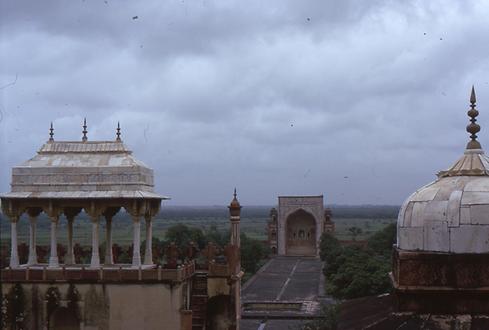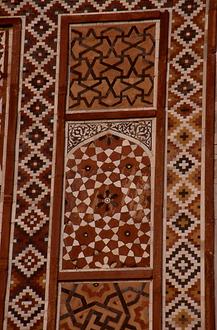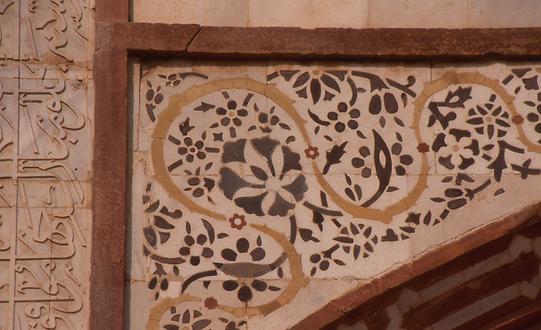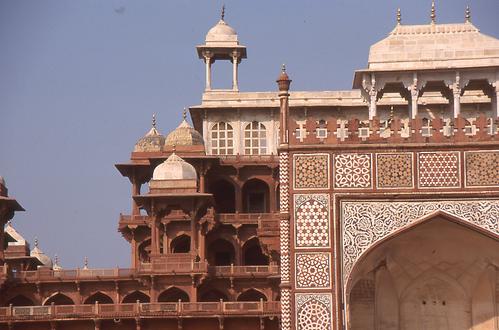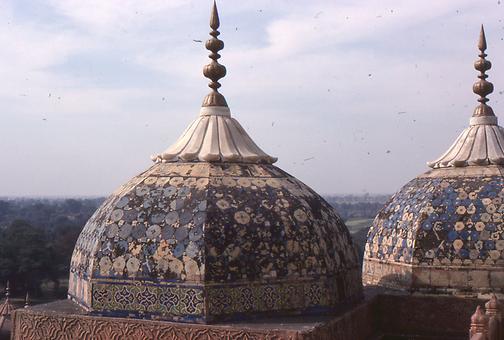Sikandra#
The Hinduistic and the Islamic India meet at the funeral monument of Mogul Akber the Great.#
All photos were taken in the years 1974, 1977 and 2001 and are part of the archive „Pictureflood Jontes”. Quite a number of the pictures have a historically important character because the upper levels are nowadays closed to visitors.
At the beginning of the sixteenth century, an Islamic dynasty expelled from Central Asia succeeded in gaining a foothold in the north of India, in annexing Hindu kingdoms and principalities and then exercising power as moguls for centuries. This name still carries the connotation that they were descendants of parts of the Mongol Empire that became islamic after Genghis Khan.
Among the rulers of this family who ruled in the area of present India and Pakistan Jalal du-Din Mohammed held a dominant position. In his lifetime, he was already called Akbar which means "the great one" and actually in Arabic "the greater one". He was the son of the Mogul Humayun, lived from 1542 to 1605 and ruled from 1561 until his death. He was buried in one of the most magnificent tomb palaces of Islamic India.
As a powerful commander, Akbar had conquered many areas largely inhabited by Hindus to expand his empire. In fact, many of them converted to Islam. As a consequence, they were able to break up the strong barriers between castes of the Hindu society and feel religiously equal with the new masters. But the masses did not convert to Islam. It is one of the great achievements of Akbar that he generously bound the new territories to himself by religious tolerance. At his court in Agra, he conducted various dialogues with representatives of other confessions, Buddhists and Hindu scholars, as well as Portuguese Jesuits, who came from Goa to his court. Further acts for the benefit of his non-Muslim subjects were the abolition of the oppressive disbelief tax, and the fact that he was even the first of his dynasty to marry a Hindu princess. However, it should not be forgotten that Akbar carried out horrific atrocities and massacres in case of insubordinate subjects or insurrections.
He also thought he could achieve an additional harmonization of the society of his empire by creating his own philosophically based religion. Persian was the court language among the Moguls and in the Central-Asian Khanates. In Persian language, the religion was called Din-i ilahi, "religion of God". Strangely enough, the religion also included a sun cult. However, this syncretistic confession existed only at his court and did not survive its founder.
His final resting place is in Sikandra in a large park ten kilometres north-west of his capital and residence Agra. The construction had already begun during Akbar's lifetime. Undoubtedly, the planning of the design includes his ideas. The gravesite was completed by his successor Jehangir in 1613.
The gateway has a large Iwan-arch, lateral galleries and four fictitious minarets. It is built of red sandstone and white marble, and its main facade is decorated with inlays according to Pietra dura of sandstone, marble and a green-blue slate. The generous decor consists of geometric and floral elements as well as inscriptions in Arabic.
The facade of the gateway is completely covered with ornaments inlaid in stone, some of which are designed that they could be extended in all directions to infinity. Since the pictorial representation of man and beast is forbidden in Islam (to a lesser extent also of plants and flowers), art has developed an immensely refined ornamentation and calligraphy which appear in technically and artificially unsurpassed inlaid stone work and earthenware tile-paintings. The art of the Monguls followed Persian models. The large supply of different stones in Rajasthan also contributes to it.
From the gateway a broad path leads through the park to the tomb.
The vast park is home to the well-groomed and beautiful Hanuman langurs with their clever looking faces.
The moguls constructed their imperial tombs not only out of a reflexion on their past and their past in the desert which they had experienced in terms of generations. Such gardens, called Bahishtabad (Persian "place of paradise"), were also an allusion to the paradise which the Quran presents to the faithful in the hereafter. Akbar‘s Park spreads over an area of 690 x 690 metres.
In the centre of this earthly garden happiness, there is the tomb of Akbar. On the upper floor which is not covered but surrounded by delicately perforated marble barriers, there is the empty tomb, a cenotaph. The barriers allow a view over the green beauty of the park.
Islamic burial customs dictate that the corps is wrapped in shrouds and buried in the earth without a coffin and burial objects. Tombs with an architectural design contain an empty coffin. The corps lies deep under the earth. Nevertheless, Akbar's cenotaph is emphasized. It is just above the spot in the middle of the building where his remains lie beneath a crypt, and is adorned with ornaments and proverbs in Arabic calligraphy. There is written Allah-hu akbar (Arabic "God is the Greater One") and Jalla-jalalahahu ("May his glory shine") on the head. On the sides, there are carvings of the 99 names of Allah.
Nowadays, a small pillar remains lonely in front of the sarcophagus. The legend tells that the largest ever known diamond, the Koh-i-Nûr ("Mountain of Light"), was exhibited there. It is proven that Akbar's successor, Jehangir, owned the diamond. The stone experienced a great deal of fate. Before it became a part of the crown jewels of Great Britain in London it was put in parts and was newly cut.
The interior with the crypt is now closed to visitors. They can only enter a small entrance hall, decorated with wall paintings in colourful splendour.
The actual tomb building is also characterized by the fact that it does not have a central dome which the Persian-inspired architecture of the Moguls would otherwise have preferred. It has an enormous side length of 105 meters and a height of five storeys.
The otherwise common central dome is missing. On the other hand, the top storeys are decorated with small kiosks with domes with no other fucntion than decoration. In Hindu architecture, the kiosks correspond to dome-shaped pavilions, the Chhatris. The word Chhatris means „umbrella“.
The ground floor of the tomb building consists of generous galleries. Shadow-producing coolness makes the heat of the summer more bearable.


